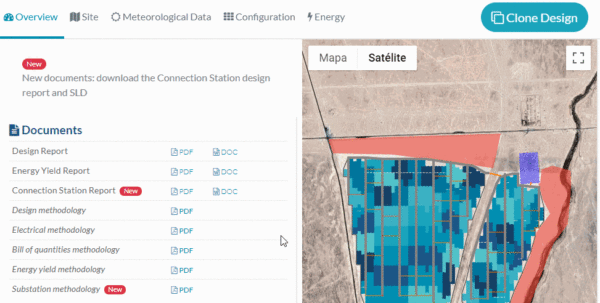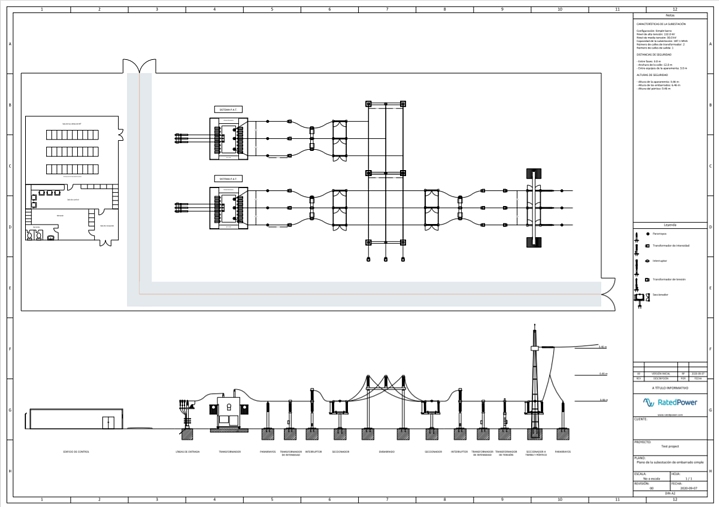From pv magazine Spain
Spain's RatedPower has included a new algorithm in its pvDesign software to optimize the development of solar plants.
It claims the algorithm presents new ways to design and engineer the point of interconnection to the grid in an efficient and precise manner. This new functionality is important in the solar industry because it is necessary to raise voltage levels from medium to high voltage in order to connect PV plants to distribution and transmission networks.
Plants need substations for this. Substations are used to accommodate new power generation, maintain reliability requirements to cope with congestion in power grids, quickly cover load and transmission capacity increases, and allow power flows to be interrupted in system failure scenarios.
The power transmission and distribution network industry is booming due to the increased average lifecycles of networks and growing demand for efficient, safe, and reliable transmission-distribution networks. The lack of an efficient electricity grid at a global level has been one of the main drivers of investments around the world. The international market for substations exceeded $151 billion in 2019. and annual installations are projected to surpass 24,500 units by 2026, according to a recent report by Global Market Insights.
Utilities generally prefer to outsource substation design. For this reason, pvDesign has launched a new function to handle basic engineering for some of the most common substations – line-transformer substations, or substations with single or double busbars.

“According to our data, 86% of pvDesign users prefer to automate the design of the electrical substation of their projects,” a company spokesperson told pv magazine. “Among users who manually choose their configuration, 60% prefer substations with simple busbars.”
The company said that 9.3% of the simulated designs in pvDesign opt to connect to the network through sectioning centers. “These stations will allow the solar plants to be connected to the grids provided that the output voltage is the same, for example, in the case of medium voltage distribution grids,” the company explained.
RatedPower claims that pvDesign fully automates basic engineering for substations, in ways that best suit PV plants. “Our users only have to select the substation card and enter the high voltage level,” the company spokesperson said. “Only with these data, our software is capable of generating in detail all the necessary documents for the substation that will allow the connection of the photovoltaic plant to the distribution or transmission networks.”
According to a recent study by the European Agency for the Cooperation of Energy Regulators (ACER), the number of transformers and busbars are two of the most important factors when setting prices for substations. This implies that substations could represent between 5% and 10% of the total cost of PV plants.
RatedPower claims that substations or sectioning centers can be customized for each project via the new algorithm. In other words, a plant's medium-voltage lines, capacity and environmental conditions are taken into account.
PvDesign generates a number of important documents in mere seconds. They include single line diagrams (SLDs) as a graphic representation of the electrical installation, and design reports that include the descriptive memory of all necessary substation equipment. Other important aspects include safety distances, insulation coordination, values of short-circuit currents, and busbar characteristics, as well as design reports that outline the descriptive memory of all sectioning-center equipment.
This content is protected by copyright and may not be reused. If you want to cooperate with us and would like to reuse some of our content, please contact: editors@pv-magazine.com.



1 comment
By submitting this form you agree to pv magazine using your data for the purposes of publishing your comment.
Your personal data will only be disclosed or otherwise transmitted to third parties for the purposes of spam filtering or if this is necessary for technical maintenance of the website. Any other transfer to third parties will not take place unless this is justified on the basis of applicable data protection regulations or if pv magazine is legally obliged to do so.
You may revoke this consent at any time with effect for the future, in which case your personal data will be deleted immediately. Otherwise, your data will be deleted if pv magazine has processed your request or the purpose of data storage is fulfilled.
Further information on data privacy can be found in our Data Protection Policy.